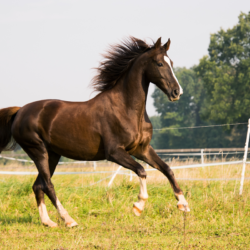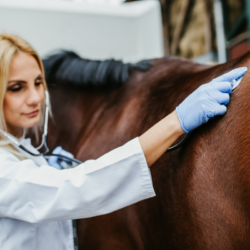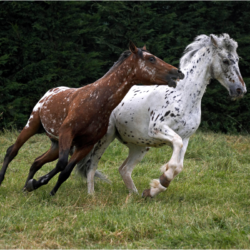Melanomas, which are particularly common in grey horses, are tumours which, although they often develop slowly, can lead to serious complications. This condition requires special attention, particularly when it comes to diagnosis, identifying symptoms and choosing appropriate treatments. This article discusses the causes, clinical manifestations and management options, with the aim of providing owners and animal health professionals with essential information to better understand and manage this condition.
What causes melanomas?
Melanomas are particularly common in grey horses, especially thoroughbred Arabians, Lipizzans and Camarguais. The main cause of this predisposition is genetic, linked to the grey coat. A mutation in the STX17 gene has been identified as being responsible for this condition. Overexpression of this gene leads to abnormal proliferation of melanocytes, the cells responsible for producing melanin, the pigment that colours the skin.
This mutation also causes progressive depigmentation in grey horses, favouring the appearance of melanomas, often in areas with little exposure to the sun, such as the perianal area, under the tail or on the lips. Unlike in humans,exposure to UV rays is not a determining factor in the development of melanoma in horses.
Statistics show that 80% of grey horses over the age of 15 will develop melanoma. The prevalence increases with age, also affecting breeds such as grey Quarter Horses and Spanish Thoroughbreds. Mainly observed in grey horses, the disease also occurs, albeit more rarely, in horses of other colours.
What are the symptoms of melanoma?
Melanomas generally appear as black nodules on areas of hairless skin, often located under the tail, in the perineal area or on the genitals. These skin masses may be single or multiple, and vary in size. Depending on the location of the tumours, horses may show a variety of symptoms.
Metastases can occur in any organ of the body, with tumours spreading via the blood or lymphatic system to the lymph nodes, liver, lungs or spinal cord. In some cases, neurological symptoms such as lameness, urinary or faecal incontinence and even colic can be observed when tumours affect the gastrointestinal tract.
Horses can also suffer from weight loss and constipation, and in the most serious cases, tumours can lead to significant obstructive lesions, seriously impacting the animal’s health.
What are the grades and types of melanoma?
Equine melanomas are classified into different grades, depending on their size, location and clinical behaviour. They range from grade 0 (no melanoma) to grade 5 (metastatic malignant tumours).
- Grade 0: No tumour.
- Grade 1: A small nodule measuring 0.5 cm in typical areas such as the perianal region.
- Grade 2: Presence of several 0.5 cm nodules or a single 2 cm nodule, always in typical locations.
- Grade 3: One or more nodules up to 5 cm, intra or subcutaneous, located in typical areas or on the lips.
- Grade 4: Extensive subcutaneous melanoma, with necrosis or ulceration, and development of metastases.
- Grade 5: Exophytic tumour growth with ulceration, presence of metastases and serious clinical signs (cachexia, fever, metabolic disorders).
Types of melanoma include :
- Melanocytic nevus: Benign tumour located in the superficial dermis, especially in young horses under 6 years of age. The tumour cells are moderately pigmented, with rare mitosis.
- Cutaneous melanoma: Present in 80% of grey horses aged over 6 years, this is an isolated tumour in the deep dermis. Cell proliferation is low, but the melanoma can develop into a malignant form.
- Cutaneous melanomatosis: Multiple melanomas, confluent in patches, often found on the tail, perineum or genitals. They appear in grey horses over 15 years of age and can metastasise.
- Malignant anaplastic melanoma: A very rare and aggressive form, this tumour develops in non-grey horses over 20 years old. It is highly metastatic and shows significant cellular pleomorphism with numerous mitoses.
How is it diagnosed?
Diagnosis of equine melanoma is based primarily on clinical observation of the skin lesions. Tumours are generally easily identified by their colour and typical location. However, in the case of amelanotic melanomas, where nodules appear without pigmentation, diagnosis becomes more complex.
The diagnosis of certainty is confirmed by a biopsy of the suspicious lesions. Fine-needle aspiration can also provide information on the nature of the tumours, but cannot determine their malignancy. It is essential to rule out other conditions such as sarcoid, lymphoma or haemangioma, which can present similar symptoms.
In some cases, additional tests, such as histopathological analysis, can be used to classify the tumour and assess its potential for metastasis. If internal melanomas are suspected, medical imaging can be useful in locating tumours in internal organs.
What treatments are available?
Several treatment options exist for horses with melanoma.
- Do nothing: When tumours are small and not bothersome, it is possible to choose not to intervene immediately. In fact, some small tumours can regress spontaneously. However, preventing exposure to UV rays is still a recommended way of limiting the worsening of the disease.
- Surgery:Surgical excision is a commonly used option, particularly for larger tumours. It may be combined with cryotherapy, a method of cooling tumour masses to destroy them. Recurrences are common, but this method is effective on small and medium-sized tumours.
- Intratumoral chemotherapy: Injections of cisplatin or carboplatin into tumours are also effective in limiting their growth. This method is often used in conjunction with surgery to prevent recurrence.
- Immunotherapy: The use of the Oncept vaccine, initially developed for dogs, has shown promising results in tumour regression. However, it is still in the evaluation phase for horses.
- Radiotherapy and hyperthermia: Radiotherapy and thermotherapy are complementary treatments, often used for more aggressive or recurrent tumours.
How can you help a horse suffering from melanoma?
In some cases, natural, non-invasive solutions can be used to keep horses with melanomas comfortable. Local hygiene is essential, especially for horses with ulcerated melanomas. Regular care with disinfectants can help prevent infections, particularly in the caudal region.
The itching caused by summer dermatitis can also aggravate the situation. Products such as Flymax Derm from the Audevard laboratory or insect repellents can relieve horses and prevent irritation. We also recommend using fly blankets to limit bites and protect sensitive areas.
In addition, if the horse suffers from constipation, dietary supplements such as bran, psyllium or linseed oil can help soften the stool, making defecation easier and reducing discomfort.
Finally, it is essential to monitor grey horses regularly for the appearance of nodules or skin masses, particularly from the age of 5. Regular veterinary monitoring allows tumours to be detected early and action to be taken before serious complications arise.





